+ Open data
Open data
- Basic information
Basic information
| Entry | Database: EMDB / ID: EMD-9895 | |||||||||
|---|---|---|---|---|---|---|---|---|---|---|
| Title | Structure of human T cell receptor-CD3 complex | |||||||||
 Map data Map data | ||||||||||
 Sample Sample |
| |||||||||
| Function / homology |  Function and homology information Function and homology informationregulation of lymphocyte apoptotic process / gamma-delta T cell receptor complex / Fc-gamma receptor III complex / T cell anergy / positive regulation of T cell anergy / positive regulation of cell-cell adhesion mediated by integrin / T cell activation involved in immune response / CD4-positive, alpha-beta T cell proliferation / Fc-gamma receptor signaling pathway / gamma-delta T cell activation ...regulation of lymphocyte apoptotic process / gamma-delta T cell receptor complex / Fc-gamma receptor III complex / T cell anergy / positive regulation of T cell anergy / positive regulation of cell-cell adhesion mediated by integrin / T cell activation involved in immune response / CD4-positive, alpha-beta T cell proliferation / Fc-gamma receptor signaling pathway / gamma-delta T cell activation / negative thymic T cell selection / positive regulation of CD4-positive, alpha-beta T cell proliferation / alpha-beta T cell receptor complex / positive thymic T cell selection / positive regulation of protein localization to cell surface / signal complex assembly / Nef and signal transduction / positive regulation of cell-matrix adhesion / T cell receptor complex / smoothened signaling pathway / establishment or maintenance of cell polarity / positive regulation of interleukin-4 production / dendrite development / Translocation of ZAP-70 to Immunological synapse / Phosphorylation of CD3 and TCR zeta chains / alpha-beta T cell activation / Generation of second messenger molecules / immunological synapse / FCGR activation / PD-1 signaling / Role of phospholipids in phagocytosis / T cell receptor binding / positive regulation of calcium-mediated signaling / negative regulation of smoothened signaling pathway / positive regulation of T cell proliferation / cell surface receptor protein tyrosine kinase signaling pathway / T cell costimulation / T cell activation / positive regulation of interleukin-2 production / cerebellum development / FCGR3A-mediated IL10 synthesis / protein tyrosine kinase binding / calcium-mediated signaling / apoptotic signaling pathway / FCGR3A-mediated phagocytosis / response to bacterium / clathrin-coated endocytic vesicle membrane / Regulation of actin dynamics for phagocytic cup formation / SH3 domain binding / transmembrane signaling receptor activity / peptide antigen binding / positive regulation of peptidyl-tyrosine phosphorylation / Immunoregulatory interactions between a Lymphoid and a non-Lymphoid cell / positive regulation of type II interferon production / cell-cell junction / protein transport / signaling receptor complex adaptor activity / Downstream TCR signaling / Cargo recognition for clathrin-mediated endocytosis / protein complex oligomerization / Clathrin-mediated endocytosis / T cell receptor signaling pathway / cell body / protein-containing complex assembly / regulation of apoptotic process / adaptive immune response / dendritic spine / cell surface receptor signaling pathway / G protein-coupled receptor signaling pathway / protein heterodimerization activity / external side of plasma membrane / negative regulation of gene expression / positive regulation of gene expression / protein kinase binding / Golgi apparatus / cell surface / endoplasmic reticulum / protein homodimerization activity / identical protein binding / membrane / plasma membrane / cytoplasm / cytosol Similarity search - Function | |||||||||
| Biological species |  Homo sapiens (human) Homo sapiens (human) | |||||||||
| Method | single particle reconstruction / cryo EM / negative staining / Resolution: 3.7 Å | |||||||||
 Authors Authors | Dong D / Zheng L / Lin J / Zhu Y / Li N / Zhang B / Xie S / Zheng J / Wang Y / Gao N / Huang Z | |||||||||
| Funding support |  China, 1 items China, 1 items
| |||||||||
 Citation Citation |  Journal: Nature / Year: 2019 Journal: Nature / Year: 2019Title: Structural basis of assembly of the human T cell receptor-CD3 complex. Authors: De Dong / Lvqin Zheng / Jianquan Lin / Bailing Zhang / Yuwei Zhu / Ningning Li / Shuangyu Xie / Yuhang Wang / Ning Gao / Zhiwei Huang /  Abstract: The αβ T cell receptor (TCR), in association with the CD3γε-CD3δε-CD3ζζ signalling hexamer, is the primary determinant of T cell development and activation, and of immune responses to foreign ...The αβ T cell receptor (TCR), in association with the CD3γε-CD3δε-CD3ζζ signalling hexamer, is the primary determinant of T cell development and activation, and of immune responses to foreign antigens. The mechanism of assembly of the TCR-CD3 complex remains unknown. Here we report a cryo-electron microscopy structure of human TCRαβ in complex with the CD3 hexamer at 3.7 Å resolution. The structure contains the complete extracellular domains and all the transmembrane helices of TCR-CD3. The octameric TCR-CD3 complex is assembled with 1:1:1:1 stoichiometry of TCRαβ:CD3γε:CD3δε:CD3ζζ. Assembly of the extracellular domains of TCR-CD3 is mediated by the constant domains and connecting peptides of TCRαβ that pack against CD3γε-CD3δε, forming a trimer-like structure proximal to the plasma membrane. The transmembrane segment of the CD3 complex adopts a barrel-like structure formed by interaction of the two transmembrane helices of CD3ζζ with those of CD3γε and CD3δε. Insertion of the transmembrane helices of TCRαβ into the barrel-like structure via both hydrophobic and ionic interactions results in transmembrane assembly of the TCR-CD3 complex. Together, our data reveal the structural basis for TCR-CD3 complex assembly, providing clues to TCR triggering and a foundation for rational design of immunotherapies that target the complex. | |||||||||
| History |
|
- Structure visualization
Structure visualization
| Movie |
 Movie viewer Movie viewer |
|---|---|
| Structure viewer | EM map:  SurfView SurfView Molmil Molmil Jmol/JSmol Jmol/JSmol |
| Supplemental images |
- Downloads & links
Downloads & links
-EMDB archive
| Map data |  emd_9895.map.gz emd_9895.map.gz | 78.5 MB |  EMDB map data format EMDB map data format | |
|---|---|---|---|---|
| Header (meta data) |  emd-9895-v30.xml emd-9895-v30.xml emd-9895.xml emd-9895.xml | 15.9 KB 15.9 KB | Display Display |  EMDB header EMDB header |
| Images |  emd_9895.png emd_9895.png | 39.6 KB | ||
| Archive directory |  http://ftp.pdbj.org/pub/emdb/structures/EMD-9895 http://ftp.pdbj.org/pub/emdb/structures/EMD-9895 ftp://ftp.pdbj.org/pub/emdb/structures/EMD-9895 ftp://ftp.pdbj.org/pub/emdb/structures/EMD-9895 | HTTPS FTP |
-Validation report
| Summary document |  emd_9895_validation.pdf.gz emd_9895_validation.pdf.gz | 444.1 KB | Display |  EMDB validaton report EMDB validaton report |
|---|---|---|---|---|
| Full document |  emd_9895_full_validation.pdf.gz emd_9895_full_validation.pdf.gz | 443.7 KB | Display | |
| Data in XML |  emd_9895_validation.xml.gz emd_9895_validation.xml.gz | 6.1 KB | Display | |
| Data in CIF |  emd_9895_validation.cif.gz emd_9895_validation.cif.gz | 6.9 KB | Display | |
| Arichive directory |  https://ftp.pdbj.org/pub/emdb/validation_reports/EMD-9895 https://ftp.pdbj.org/pub/emdb/validation_reports/EMD-9895 ftp://ftp.pdbj.org/pub/emdb/validation_reports/EMD-9895 ftp://ftp.pdbj.org/pub/emdb/validation_reports/EMD-9895 | HTTPS FTP |
-Related structure data
| Related structure data |  6jxrMC M: atomic model generated by this map C: citing same article ( |
|---|---|
| Similar structure data |
- Links
Links
| EMDB pages |  EMDB (EBI/PDBe) / EMDB (EBI/PDBe) /  EMDataResource EMDataResource |
|---|---|
| Related items in Molecule of the Month |
- Map
Map
| File |  Download / File: emd_9895.map.gz / Format: CCP4 / Size: 83.7 MB / Type: IMAGE STORED AS FLOATING POINT NUMBER (4 BYTES) Download / File: emd_9895.map.gz / Format: CCP4 / Size: 83.7 MB / Type: IMAGE STORED AS FLOATING POINT NUMBER (4 BYTES) | ||||||||||||||||||||||||||||||||||||||||||||||||||||||||||||
|---|---|---|---|---|---|---|---|---|---|---|---|---|---|---|---|---|---|---|---|---|---|---|---|---|---|---|---|---|---|---|---|---|---|---|---|---|---|---|---|---|---|---|---|---|---|---|---|---|---|---|---|---|---|---|---|---|---|---|---|---|---|
| Projections & slices | Image control
Images are generated by Spider. | ||||||||||||||||||||||||||||||||||||||||||||||||||||||||||||
| Voxel size | X=Y=Z: 1.057 Å | ||||||||||||||||||||||||||||||||||||||||||||||||||||||||||||
| Density |
| ||||||||||||||||||||||||||||||||||||||||||||||||||||||||||||
| Symmetry | Space group: 1 | ||||||||||||||||||||||||||||||||||||||||||||||||||||||||||||
| Details | EMDB XML:
CCP4 map header:
| ||||||||||||||||||||||||||||||||||||||||||||||||||||||||||||
-Supplemental data
- Sample components
Sample components
-Entire : complex
| Entire | Name: complex |
|---|---|
| Components |
|
-Supramolecule #1: complex
| Supramolecule | Name: complex / type: complex / ID: 1 / Parent: 0 / Macromolecule list: all |
|---|---|
| Source (natural) | Organism:  Homo sapiens (human) Homo sapiens (human) |
| Recombinant expression | Organism:  Homo sapiens (human) Homo sapiens (human) |
-Macromolecule #1: T-cell surface glycoprotein CD3 zeta chain
| Macromolecule | Name: T-cell surface glycoprotein CD3 zeta chain / type: protein_or_peptide / ID: 1 / Number of copies: 2 / Enantiomer: LEVO |
|---|---|
| Source (natural) | Organism:  Homo sapiens (human) Homo sapiens (human) |
| Molecular weight | Theoretical: 18.723439 KDa |
| Recombinant expression | Organism:  Homo sapiens (human) Homo sapiens (human) |
| Sequence | String: MKWKALFTAA ILQAQLPITE AQSFGLLDPK LCYLLDGILF IYGVILTALF LRVKFSRSAD APAYQQGQNQ LYNELNLGRR EEYDVLDKR RGRDPEMGGK PQRRKNPQEG LYNELQKDKM AEAYSEIGMK GERRRGKGHD GLYQGLSTAT KDTYDALHMQ A LPPR |
-Macromolecule #2: T-cell surface glycoprotein CD3 delta chain
| Macromolecule | Name: T-cell surface glycoprotein CD3 delta chain / type: protein_or_peptide / ID: 2 / Number of copies: 1 / Enantiomer: LEVO |
|---|---|
| Source (natural) | Organism:  Homo sapiens (human) Homo sapiens (human) |
| Molecular weight | Theoretical: 18.949537 KDa |
| Recombinant expression | Organism:  Homo sapiens (human) Homo sapiens (human) |
| Sequence | String: MEHSTFLSGL VLATLLSQVS PFKIPIEELE DRVFVNCNTS ITWVEGTVGT LLSDITRLDL GKRILDPRGI YRCNGTDIYK DKESTVQVH YRMCQSCVEL DPATVAGIIV TDVIATLLLA LGVFCFAGHE TGRLSGAADT QALLRNDQVY QPLRDRDDAQ Y SHLGGNWA RNK |
-Macromolecule #3: T-cell surface glycoprotein CD3 epsilon chain
| Macromolecule | Name: T-cell surface glycoprotein CD3 epsilon chain / type: protein_or_peptide / ID: 3 / Number of copies: 2 / Enantiomer: LEVO |
|---|---|
| Source (natural) | Organism:  Homo sapiens (human) Homo sapiens (human) |
| Molecular weight | Theoretical: 23.174227 KDa |
| Recombinant expression | Organism:  Homo sapiens (human) Homo sapiens (human) |
| Sequence | String: MQSGTHWRVL GLCLLSVGVW GQDGNEEMGG ITQTPYKVSI SGTTVILTCP QYPGSEILWQ HNDKNIGGDE DDKNIGSDED HLSLKEFSE LEQSGYYVCY PRGSKPEDAN FYLYLRARVC ENCMEMDVMS VATIVIVDIC ITGGLLLLVY YWSKNRKAKA K PVTRGAGA ...String: MQSGTHWRVL GLCLLSVGVW GQDGNEEMGG ITQTPYKVSI SGTTVILTCP QYPGSEILWQ HNDKNIGGDE DDKNIGSDED HLSLKEFSE LEQSGYYVCY PRGSKPEDAN FYLYLRARVC ENCMEMDVMS VATIVIVDIC ITGGLLLLVY YWSKNRKAKA K PVTRGAGA GGRQRGQNKE RPPPVPNPDY EPIRKGQRDL YSGLNQRRI |
-Macromolecule #4: T-cell surface glycoprotein CD3 gamma chain
| Macromolecule | Name: T-cell surface glycoprotein CD3 gamma chain / type: protein_or_peptide / ID: 4 / Number of copies: 1 / Enantiomer: LEVO |
|---|---|
| Source (natural) | Organism:  Homo sapiens (human) Homo sapiens (human) |
| Molecular weight | Theoretical: 20.493457 KDa |
| Recombinant expression | Organism:  Homo sapiens (human) Homo sapiens (human) |
| Sequence | String: MEQGKGLAVL ILAIILLQGT LAQSIKGNHL VKVYDYQEDG SVLLTCDAEA KNITWFKDGK MIGFLTEDKK KWNLGSNAKD PRGMYQCKG SQNKSKPLQV YYRMCQNCIE LNAATISGFL FAEIVSIFVL AVGVYFIAGQ DGVRQSRASD KQTLLPNDQL Y QPLKDRED DQYSHLQGNQ LRRN |
-Macromolecule #5: T cell receptor alpha variable 12-3,Possible J 11 gene segment,T ...
| Macromolecule | Name: T cell receptor alpha variable 12-3,Possible J 11 gene segment,T cell receptor alpha constant type: protein_or_peptide / ID: 5 Details: fusion protein of residues 22-114 from A0A0B4J271, residues 116-132 from A0N4Z6 and residues 134-273 from P01848. Number of copies: 1 / Enantiomer: LEVO |
|---|---|
| Source (natural) | Organism:  Homo sapiens (human) Homo sapiens (human) |
| Molecular weight | Theoretical: 28.308662 KDa |
| Recombinant expression | Organism:  Homo sapiens (human) Homo sapiens (human) |
| Sequence | String: QQKEVEQDPG PLSVPEGAIV SLNCTYSNSA FQYFMWYRQY SRKGPELLMY TYSSGNKEDG RFTAQVDKSS KYISLFIRDS QPSDSATYL CAMSKGYSTL TFGKGTMLLV SPDIQNPDPA VYQLRDSKSS DKSVCLFTDF DSQTNVSQSK DSDVYITDKT V LDMRSMDF ...String: QQKEVEQDPG PLSVPEGAIV SLNCTYSNSA FQYFMWYRQY SRKGPELLMY TYSSGNKEDG RFTAQVDKSS KYISLFIRDS QPSDSATYL CAMSKGYSTL TFGKGTMLLV SPDIQNPDPA VYQLRDSKSS DKSVCLFTDF DSQTNVSQSK DSDVYITDKT V LDMRSMDF KSNSAVAWSN KSDFACANAF NNSIIPEDTF FPSPESSCDV KLVEKSFETD TNLNFQNLSV IGFRILLLKV AG FNLLMTL RLWSS |
-Macromolecule #6: T cell receptor beta variable 6-5,M1-specific T cell receptor bet...
| Macromolecule | Name: T cell receptor beta variable 6-5,M1-specific T cell receptor beta chain,T cell receptor beta constant 2 type: protein_or_peptide / ID: 6 Details: fusion protein of residues 22-112 from A0A0K0K1A5, residues 121-134 from P0DSE2 and residues 135-312 from A0A0G2JMB4. Number of copies: 1 / Enantiomer: LEVO |
|---|---|
| Source (natural) | Organism:  Homo sapiens (human) Homo sapiens (human) |
| Molecular weight | Theoretical: 32.498463 KDa |
| Recombinant expression | Organism:  Homo sapiens (human) Homo sapiens (human) |
| Sequence | String: GVTQTPKFQV LKTGQSMTLQ CAQDMNHEYM SWYRQDPGMG LRLIHYSVGA GITDQGEVPN GYNVSRSTTE DFPLRLLSAA PSQTSVYFC ASRRRQGASG EQYFGPGTRL TVTEDLKNVF PPEVAVFEPS EAEISHTQKA TLVCLATGFY PDHVELSWWV N GKEVHSGV ...String: GVTQTPKFQV LKTGQSMTLQ CAQDMNHEYM SWYRQDPGMG LRLIHYSVGA GITDQGEVPN GYNVSRSTTE DFPLRLLSAA PSQTSVYFC ASRRRQGASG EQYFGPGTRL TVTEDLKNVF PPEVAVFEPS EAEISHTQKA TLVCLATGFY PDHVELSWWV N GKEVHSGV STDPQPLKEQ PALNDSRYCL SSRLRVSATF WQNPRNHFRC QVQFYGLSEN DEWTQDRAKP VTQIVSAEAW GR ADCGFTS ESYQQGVLSA TILYEILLGK ATLYAVLVSA LVLMAMVKRK DSRG |
-Experimental details
-Structure determination
| Method | negative staining, cryo EM |
|---|---|
 Processing Processing | single particle reconstruction |
| Aggregation state | cell |
- Sample preparation
Sample preparation
| Buffer | pH: 7.5 |
|---|---|
| Staining | Type: NEGATIVE / Material: Uranyl Acetate |
| Vitrification | Cryogen name: NITROGEN |
- Electron microscopy
Electron microscopy
| Microscope | FEI TITAN KRIOS |
|---|---|
| Image recording | Film or detector model: GATAN K2 SUMMIT (4k x 4k) / Average electron dose: 64.4 e/Å2 |
| Electron beam | Acceleration voltage: 300 kV / Electron source:  FIELD EMISSION GUN FIELD EMISSION GUN |
| Electron optics | Illumination mode: SPOT SCAN / Imaging mode: DARK FIELD |
| Experimental equipment |  Model: Titan Krios / Image courtesy: FEI Company |
- Image processing
Image processing
| Final reconstruction | Applied symmetry - Point group: C1 (asymmetric) / Resolution.type: BY AUTHOR / Resolution: 3.7 Å / Resolution method: FSC 0.143 CUT-OFF / Number images used: 197487 |
|---|---|
| Initial angle assignment | Type: MAXIMUM LIKELIHOOD |
| Final angle assignment | Type: MAXIMUM LIKELIHOOD |
 Movie
Movie Controller
Controller



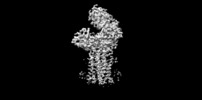

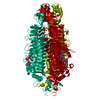
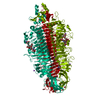
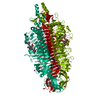

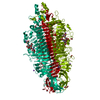
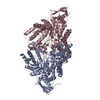
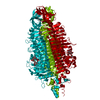
















 Z (Sec.)
Z (Sec.) Y (Row.)
Y (Row.) X (Col.)
X (Col.)





















